 Soviet Military Power
Soviet Military Power Soviet Military Power
Soviet Military Power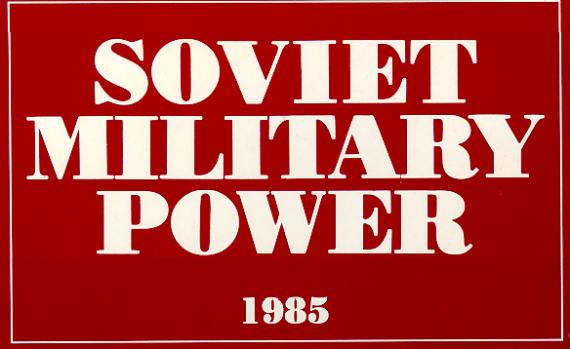
In the year since the publication of Soviet Military Power 1984, the Soviet Union has pressed ahead with the development and deployment of new generations of increasingly capable land, sea, and air forces for nuclear attack. As modernization of the fourth generation of intercontinental ballistic missiles (ICBMs) has neared completion - ICBMs with greater accuracy and survivability - the USSR has moved with great speed in the development and test firing of a fifth generation of ICBM, with a new dimension of capability - mobility that increases its survivability.
As the USSR's strategic nuclear-powered ballistic missile submarine (SSBN) force has increased its capability with the introduction of each new TYPHOON-Class SSBN, the Soviets have launched a new SSBN - the DELTA IV - as the platform for their most capable long-range multiple independently targetable reentry vehicle (MIRVed) submarine-launched ballistic missile (SLBM), the SS-NX-23.
The USSR now has three manned strategic bombers in production and development - the BACKFIRE, the BEAR H. and the BLACKJACK. With the reopening of the BEAR production line, the Soviets are producing a new, upgraded variant of the BEAR turboprop bomber, thereby increasing their long-range bomber force. Newly built BEAR H bombers have become the launch platform for the nonoperational long-range AS-15 air-launched cruise missile.
The modernization and upgrading of these strategic forces have been paralleled by growth and increased capabilities of the Soviets' longer range intermediate-range nuclear (LRINF) and short-range ballistic missile (SRBM) systems deployed with Soviet combat forces. Significant improvements in nuclear capable aircraft, as well as increases in tactical missiles and nuclear artillery, have also occurred.
Soviet leaders since Khrushchev have followed a consistent and relentless policy for the development of forces for nuclear attack. The Soviet leadership, however, recognizes the catastrophic consequences of nuclear war. The grand strategy of the USSR, therefore, is to attain its objectives, if possible, by means short of war - exploiting the coercive leverage inherent in superior forces, particularly nuclear forces, to instill fear, to erode the West's collective security arrangements, and to support subversion. Thus, the primary role of Soviet military power is to provide the essential underpinning for the step-by-step extension of Soviet influence and control.
 In a global conflict, Soviet strategic policy would be to destroy Western nuclear forces before launch or in flight to their targets; to ensure national survival should nuclear weapons reach the Soviet homeland; and to support and sustain combined arms combat in several theaters of military operations. From these policy directives come several overarching strategic wartime missions:
In a global conflict, Soviet strategic policy would be to destroy Western nuclear forces before launch or in flight to their targets; to ensure national survival should nuclear weapons reach the Soviet homeland; and to support and sustain combined arms combat in several theaters of military operations. From these policy directives come several overarching strategic wartime missions:
- eliminate Western nuclear capabilities and related supporting facilities;
- seize and occupy vital areas on the Eurasian landmass; and
- defend the Soviet State against attack.
These missions would involve:
- disruption and destruction of the West's essential command, control, and communications capabilities;
- destruction or neutralization of the West's nuclear forces on the ground or at sea before they could be launched; and
- protection of the Soviet leadership and cadres, military forces, and military and economic assets necessary to sustain the war.
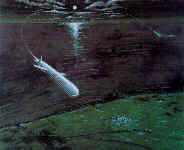 The Soviets believe that a conventional war in Europe might escalate to the nuclear level despite their oft-repeated commitment to no first-use of nuclear weapons, the Soviets have developed extensive plans either to preempt a NATO nuclear strike by launching a massive attack, or to launch a massive first strike against prime NATO targets should their conventional operations falter.
The Soviets believe that a conventional war in Europe might escalate to the nuclear level despite their oft-repeated commitment to no first-use of nuclear weapons, the Soviets have developed extensive plans either to preempt a NATO nuclear strike by launching a massive attack, or to launch a massive first strike against prime NATO targets should their conventional operations falter.
Strategic and theater forces and programs in place or under active development designed to accomplish these objectives include:
- hard-target-capable ICBMs, LRINF ballistic missiles, and land-based cruise missiles;
- short-range ballistic missiles (SRBMs) and free rocket over ground (FROG) systems deployed with combat troops;
- bombers and air-launched cruise missiles(ALCMs) designed to penetrate US and Allied defensive systems;
- submarine-launched ballistic missiles and cruise missiles (SLCMs) on various platforms;
- antisubmarine warfare (ASW) forces to attack Western nuclear-powered ballistic missile submarines;
- air and missile defenses, including early warning satellites and radars, interceptor aircraft, surface-to-air missiles (SAMs),antiballistic missile (ABM) radars and interceptors, and some antiaircraft artillery;
- antisatellite weapons;
- passive defense forces, including civil defense forces and countermeasures troops and equipment devoted to confusing incoming aircraft; and
- Hardened facilities numbering in the thousands, command vehicles, and evacuation plans designed to protect Party, military, governmental and industrial staffs, essential workers, and to the extent possible, the general population.
Supporting a land war in Eurasia and eliminating the US capacity to fight and support a conflict would require the capability to employ theater and strategic forces over a variety of ranges and the destruction of:
- other military-associated command and control;
- war-supporting industries, arsenals, and major military facilities;
- ports and airfields in the United States and those along sea and air routes to European and Asian theaters of war; and
- satellite surveillance sensors, ground-based surveillance sensors, related facilities, and communications.
Offensive forces (ICBMs, LRINF, SLBMs, SRBMs, cruise missiles, and bombers) and antisatellite weapons would generally be assigned these tasks. In some cases, special purpose forces could be used for these missions, especially in Eurasia. These tasks would be generally less demanding than those in the prime category.
Soviet nuclear forces are designed and personnel trained to fulfill their missions under all circumstances. In a nuclear exchange, the Soviets believe the most favorable circumstance would be a preemptive strike; the least favorable would be a follow-on strike after nuclear weapons hit the USSR. The Soviets have training programs intended to enable nuclear forces to operate under all circumstances. Moreover, the Soviets appear to believe that nuclear war might last weeks or even months and have factored that into their force planning.
- The key to success in preemption would be effective coordination of the strike and sound intelligence on Western intentions. During wartime, the main mission of Soviet intelligence would be to determine the West's intended courses of action. Meeting these demands in war requires reliable command, control, and communications under all conditions.
- A launch-under-attack circumstance would place a great stress on attack warning systems and launch coordination. To meet this demand the Soviets have established a satellite-based ICBM launch-detection system, built an over-the-horizon radar missile launch-detection system to back up the satellites, and have large phased-array radars ringing the USSR. These warning systems could give the Soviets time to launch their forces very quickly.
- Follow-on strikes would require the survivability of the command, control, and communications systems as well as the weapons themselves. The Soviets have invested heavily in providing this survivability. The SS-17, SS-18, and SS-19 ICBMs are housed in the world's hardest silos. Silo deployment has been adopted for ABMs as well. To increase survivability, the SS-20 LRINF missile is mobile. Mobile ICBMs are nearing deployment, and a mobile strategic surface-to-air missile is almost operational. The launch control facilities for offensive missiles are housed in very hard silos or on off-road vehicles. Communications are redundant and hardened. Higher commands have multiple mobile alternate command posts available for their use, including land vehicles, trains, aircraft, and ships. Bombers are assigned dispersal airfields. Ballistic missile submarines could be submerged in deep fjords just off their piers or dispersed while being protected by Soviet surface and submarine forces.
- The belief that a nuclear war might be protracted has led to the USSR's emphasis on survivability along with war reserves, protection for essential personnel and equipment, and the capacity to reload launchers. For their ICBM, LRINF, SRBM, and air defense forces, the Soviets have stocked extra missiles, propellants, and warheads throughout the USSR. Some ICBM silo launchers could be reloaded, and provisions have been made for the decontamination of those launchers. Plans for the survival of necessary equipment and personnel have been developed and practiced. Resupply systems are available to reload SSBNs in protected waters.
Even with these ambitious development and deployment programs, the Soviets continue to modernize all elements of their nuclear attack forces. At the same time, the Soviet leadership has been directing a campaign to support and amplify ongoing antinuclear movements in the West to influence, delay, or frustrate Western nuclear force programs. Using this two pronged approach, Moscow seeks new gains in relative capability despite the drive of Western governments to redress the imbalance that has developed over the past decade.
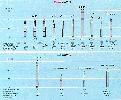 The operational Soviet ICBM force consists of some 1,400 silo launchers, aside from those at test sites. Some 818 of these launchers have been rebuilt since 1972. Nearly half of these silos are new versions of the original designs and have been reconstructed or modified in the past six years. All 818 silos have been hardened better to withstand attack by currently operational US ICBMs. These silos contain the world's most modern deployed ICBMs - the SS-17 Mod 3 (150 silos), the SS-18 Mod 4 (308), and the SS-19 Mod 3 (360). Deployment of these ICBMs began just six years ago.
The operational Soviet ICBM force consists of some 1,400 silo launchers, aside from those at test sites. Some 818 of these launchers have been rebuilt since 1972. Nearly half of these silos are new versions of the original designs and have been reconstructed or modified in the past six years. All 818 silos have been hardened better to withstand attack by currently operational US ICBMs. These silos contain the world's most modern deployed ICBMs - the SS-17 Mod 3 (150 silos), the SS-18 Mod 4 (308), and the SS-19 Mod 3 (360). Deployment of these ICBMs began just six years ago.
The highly accurate SS-18 and SS-19 ICBMs carry more and larger Multiple Independently-Targetable Reentry Vehicles (MIRVs) than the MINUTEMAN III, the most modern US ICBM. The SS-18 Mod 4 carries ten MIRVs, and the SS-19 Mod 3 carries six, whereas the MINUTEMAN III carries only three. The SS-18 Mod 4 was specifically designed to attack and destroy ICBM silos and other hardened targets in the United States. Each of its 10 warheads has more than 20 times the destructive power of the nuclear devices developed during World War II. The SS-18 Mod 4 force currently deployed has the capability to destroy more than 80 percent of US ICBM silos using two nuclear warheads against each. The SS-19 Mod 3 ICBM could be assigned similar missions and, in addition, could be used against targets in Eurasia. Although the SS-17 Mod 3 is somewhat less capable than the SS-19, it has similar targeting flexibility.
The remaining 580 Soviet ICBM silos are fitted with the SS-11 - 420 SS-11 Mod 2/3s, 100 SS-1I Mod Is - and 60 SS-13 Mod 2s. These ICBMs of older vintage 1966 and 1973 initial deployment, respectively - are housed in less-survivable silos and are considerably less capable. Nevertheless, their destructive potential against softer area targets in the United States and Eurasia is significant in terms of many of the Soviet nuclear requirements outlined above.
 The SS-16 is a three-stage, solid-propellant, single-RV ICBM that the Soviets claim has not been deployed. The system was first tested in 1972; the last known test took place in 1976. The SS-20 LRINF missile is closely related to the SS-16. The SS-16 probably was intended originally for both silo and mobile deployment, using equipment and a basing arrangement comparable to that used with the SS-20. The Soviet Union agreed in SALT II not to produce, test, or deploy ICBMs of the SS-16 type and, in particular, not to produce the SS-16 third stage, the RV, or the appropriate device for targeting the RV of that missile. While the evidence is somewhat ambiguous, it indicates that the SS-16 activities at Plesetsk are a probable violation of SALT II, which banned SS-16 deployment.
The SS-16 is a three-stage, solid-propellant, single-RV ICBM that the Soviets claim has not been deployed. The system was first tested in 1972; the last known test took place in 1976. The SS-20 LRINF missile is closely related to the SS-16. The SS-16 probably was intended originally for both silo and mobile deployment, using equipment and a basing arrangement comparable to that used with the SS-20. The Soviet Union agreed in SALT II not to produce, test, or deploy ICBMs of the SS-16 type and, in particular, not to produce the SS-16 third stage, the RV, or the appropriate device for targeting the RV of that missile. While the evidence is somewhat ambiguous, it indicates that the SS-16 activities at Plesetsk are a probable violation of SALT II, which banned SS-16 deployment.
Deployment programs for all of the currently operational Soviet ICBM systems are complete. The command, control, and communications system that supports the Soviet ICBM force is modern and highly survivable, and the reliability of the ICBMs themselves is regularly tested by live firings from operational complexes.
Those ICBMs in the current force that the Soviets decide not to replace with modified or new ICBMs will, in accord with past practice, be refurbished to increase their useful lifetime. During this process, some system modifications could also be made. Through this capacity for refurbishment, the Soviets can sustain a higher level of confidence in system reliability over a longer term than would otherwise be possible.
Force Developments. Soviet research and development on ICBMs is a dynamic process involving many programs. The completion of current deployment programs probably marks the end of significant Soviet investment in the development of entirely new liquid-propellant ICBMs. Modified versions of the SS-18, however, are likely to be produced and deployed in existing silos in the future.
The Soviets appear to be planning on new solid-propellant ICBMs to meet future mission requirements, including a counterforce capability and ICBM force survivability. Two new solid-propellant ICBMs, the medium-size SS-X-24 and the smaller SS-X-25, are well along in their flight test programs from the range head at Plesetsk in the Soviet north. A mobile version of each of these systems will be deployed.
The SS-X-24 will probably be silo-deployed at first, with initial deployment expected in 1986. Rail-mobile deployment could follow by one to two years. Early preparations for the deployment of the SS-X-24 are already underway.
The SS-X-25 is approximately the same size as the US MINUTEMAN ICBM. It will carry a single reentry vehicle. The SS-X-25 has apparently been designed for road-mobile deployment similar to that of the SS-20; as such it will be highly survivable with an inherent refire capability. Two bases, probably for the SS-X-25, are nearing operational capability. They consist of launcher garages equipped with sliding roofs and several support buildings to house the necessary mobile support equipment.
Recent activity at the Soviet ICBM test ranges indicates that two additional new ICBMs are under development. A new ICBM to replace the SS-18 is nearing the flight test stage of development. Additionally, a solid propellant missile that may be larger than the SS-X-24 will begin flight testing in the next few years. Both of these missiles are likely to have better accuracy and greater throwweights than their predecessors.
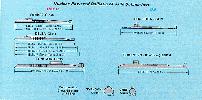 The Soviets maintain the world's largest ballistic missile submarine force. As of early 1985, the force numbered 62 modern SSBNs carrying 928 nuclear-tipped missiles. These totals do not include 13 older submarines with 39 missiles currently assigned theater missions. Eighteen SSBNs are fitted with 300 MIRVed submarine-launched ballistic missiles (SLBMs). These 18 units have been built and deployed within the past 8 years. Over two-thirds of the ballistic missile submarines, including those equipped with MIRVed missiles are fitted with long-range SLBMs that enable the submarines to patrol in waters close to the Soviet Union. This affords protection from NATO antisubmarine warfare operations. Moreover, the long range missiles allow the Soviets to fire from home ports, if necessary, and still strike targets in the United States.
The Soviets maintain the world's largest ballistic missile submarine force. As of early 1985, the force numbered 62 modern SSBNs carrying 928 nuclear-tipped missiles. These totals do not include 13 older submarines with 39 missiles currently assigned theater missions. Eighteen SSBNs are fitted with 300 MIRVed submarine-launched ballistic missiles (SLBMs). These 18 units have been built and deployed within the past 8 years. Over two-thirds of the ballistic missile submarines, including those equipped with MIRVed missiles are fitted with long-range SLBMs that enable the submarines to patrol in waters close to the Soviet Union. This affords protection from NATO antisubmarine warfare operations. Moreover, the long range missiles allow the Soviets to fire from home ports, if necessary, and still strike targets in the United States.
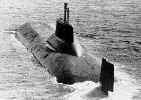 Three units of one of the most modern Soviet ballistic missile submarine, the TYPHOON, have already been built. Each TYPHOON carries 20 SS-N-20 solid-propellant MIRVed SLBMs. The TYPHOON is the world's largest submarine, with a displacement of 25,000 tons, one-third greater than the US OHIO-Class. The submarine can operate under the Arctic Ocean icecap, adding further to the protection afforded by the 8,300-kilometer range of the SS-N-20 SLBM. Three or four additional TYPHOONs are probably now under construction and, by the early 1990s, the Soviets could have as many as eight of these potent weapons systems in their operational force.
Three units of one of the most modern Soviet ballistic missile submarine, the TYPHOON, have already been built. Each TYPHOON carries 20 SS-N-20 solid-propellant MIRVed SLBMs. The TYPHOON is the world's largest submarine, with a displacement of 25,000 tons, one-third greater than the US OHIO-Class. The submarine can operate under the Arctic Ocean icecap, adding further to the protection afforded by the 8,300-kilometer range of the SS-N-20 SLBM. Three or four additional TYPHOONs are probably now under construction and, by the early 1990s, the Soviets could have as many as eight of these potent weapons systems in their operational force.
In accordance with the SALT I Interim Agreement, the Soviets have, since 1978, removed 12 YANKEE I units from service as ballistic missile submarines. These units had to be removed as newer submarines were produced in order for the overall Soviet SSBN force to stay within 62 modern SSBN/950 SLBM limits established in 1972. These YANKEEs, however, have not been scrapped. Some have been reconfigured as attack or cruise missile submarines.
The Soviets may have begun to assign theater attack missions to some of the 21 remaining YANKEE I submarines. However, YANKEE patrols targeted against the United States continue.
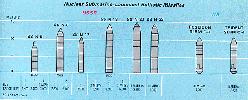 Force Developments. The Soviets have launched two units of a new class of SSBN, the DELTA IV, which will be fitted with the SS-NX-23 SLBM, now being flight tested. This large, liquid-propelled SLBM will have greater throwweight, carry more warheads, and be more accurate than the SS-N-18, which is carried on the DELTA III SSBN. The SS-NX-23 is likely to be deployed on DELTA IIIs as a replacement for the SS-N-18 as well as on the new DELTA IVs.
Force Developments. The Soviets have launched two units of a new class of SSBN, the DELTA IV, which will be fitted with the SS-NX-23 SLBM, now being flight tested. This large, liquid-propelled SLBM will have greater throwweight, carry more warheads, and be more accurate than the SS-N-18, which is carried on the DELTA III SSBN. The SS-NX-23 is likely to be deployed on DELTA IIIs as a replacement for the SS-N-18 as well as on the new DELTA IVs.
 The Soviets will probably begin flight testing a modified version of the SS-N-20. Additionally,
based on past Soviet practice, they may initiate testing of a modified version of the SS-NX-23 before the end of the 1980s. Both modified versions of the SS-N-20 and SS-NX-23 are likely to be more accurate than their predecessors.
The Soviets will probably begin flight testing a modified version of the SS-N-20. Additionally,
based on past Soviet practice, they may initiate testing of a modified version of the SS-NX-23 before the end of the 1980s. Both modified versions of the SS-N-20 and SS-NX-23 are likely to be more accurate than their predecessors.
To ensure communication reliability, the Soviets emphasize redundant and timely command and control for their military forces, especially those for intercontinental attack. The Soviets are expected to deploy an extremely low frequency (ELF) communications system that will enable them to contact SSBNs under most operating conditions.
- Smolensk Air Army;
- Legnica Air Army;
- Venitza Air Army;
- Irkutsk Air Army; and
- Moscow Air Army.
These armies were established to place Soviet strategic aircraft on a footing in peace time that would facilitate the transition to wartime. The armies are focused on potential conflicts in Europe, Asia, and the United States.
Strategic aviation assets include some 170 BEAR and BISON bombers and about 250 BACKFIRE bombers (including 120 BACKFIRE bombers in Soviet Naval Aviation). The Soviets also have 360 medium-range BLINDER and BADGER bombers; 450 shorter range FENCER strike aircraft; and 530 tanker, reconnaissance, and electronic warfare aircraft. The Soviets have allocated these aircraft among the five air armies to provide support for specific theaters of military operations and to assure the flexibility to reallocate aircraft as necessary during wartime. The intercontinental BEAR and BISON bombers are available for maritime and Eurasian missions, and the BACKFIRE can be used against the United States. This flexibility allows the Soviets to focus their strategic air assets as circumstances require.
The Soviets have taken recent steps that indicate greatly increased interest in their long range strategic bomber force. An entirely new variant of the BEAR bomber - the BEAR H - is now operational with the AS-15 long-range cruise missile. This is the first new production of a strike version of the BEAR airframe in over 15 years. In addition, older BEAR aircraft configured to carry air-to-surface missiles (ASMs) are being reconfigured to carry the newer, supersonic AS-4 missile in place of the subsonic AS-3. Several of these reconfigurations (BEAR G) have been completed. With the BEAR H in series production, the decline in the inventory of BEAR aircraft, characteristic of recent years, has been reversed.
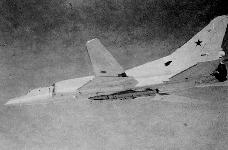 The BACKFIRE is the most modern operational Soviet bomber. The Soviets continue to produce this aircraft at a rate of at least 30 per year; this production rate is likely to be maintained at least through the end of the decade. The original design has been modified several times, and further modifications are likely to be made to upgrade aircraft performance. The BACKFIRE is a long-range aircraft capable of performing nuclear strike, conventional attack, antiship, and reconnaissance missions. The BACKFIRE can be equipped with a probe to permit in-flight
The BACKFIRE is the most modern operational Soviet bomber. The Soviets continue to produce this aircraft at a rate of at least 30 per year; this production rate is likely to be maintained at least through the end of the decade. The original design has been modified several times, and further modifications are likely to be made to upgrade aircraft performance. The BACKFIRE is a long-range aircraft capable of performing nuclear strike, conventional attack, antiship, and reconnaissance missions. The BACKFIRE can be equipped with a probe to permit in-flight 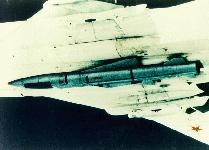 refueling to increase its range and radius capabilities. It could be used against the contiguous United States on high-altitude subsonic missions. Its low-altitude supersonic dash capabilities make it a formidable weapon to support military operations in Europe and Asia as well.
refueling to increase its range and radius capabilities. It could be used against the contiguous United States on high-altitude subsonic missions. Its low-altitude supersonic dash capabilities make it a formidable weapon to support military operations in Europe and Asia as well.
 The Soviets have some FENCER strike aircraft assigned to strategic aviation. The FENCER is a supersonic, variable-geometry wing, all-weather fighter-bomber that first reached operational status in 1974. Three variants have been developed, the most recent introduced in 1981. The aircraft is still in production, and the number assigned to strategic aviation is likely to increase over the next few years.
The Soviets have some FENCER strike aircraft assigned to strategic aviation. The FENCER is a supersonic, variable-geometry wing, all-weather fighter-bomber that first reached operational status in 1974. Three variants have been developed, the most recent introduced in 1981. The aircraft is still in production, and the number assigned to strategic aviation is likely to increase over the next few years.
 Force Developments. The new Soviet long range bomber, the BLACKJACK, is in the flight test stage of development. The BLACKJACK is larger than the US B-1B, probably will be faster, and may have about the same combat radius. This new bomber could be operational by 1988. The BLACKJACK will be capable of carrying cruise missiles, bombs, or a combination of both. It probably will first replace the much less capable BISON bomber and then the BEAR A bomber.
Force Developments. The new Soviet long range bomber, the BLACKJACK, is in the flight test stage of development. The BLACKJACK is larger than the US B-1B, probably will be faster, and may have about the same combat radius. This new bomber could be operational by 1988. The BLACKJACK will be capable of carrying cruise missiles, bombs, or a combination of both. It probably will first replace the much less capable BISON bomber and then the BEAR A bomber.
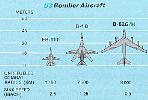 A new aerial-refueling tanker aircraft, based on the Il-76/CANDID, has been under development for several years. When deployed in the near future, the new tanker will support tactical and strategic aircraft and will significantly improve the ability of Soviet aircraft to conduct longer range operations.
A new aerial-refueling tanker aircraft, based on the Il-76/CANDID, has been under development for several years. When deployed in the near future, the new tanker will support tactical and strategic aircraft and will significantly improve the ability of Soviet aircraft to conduct longer range operations.
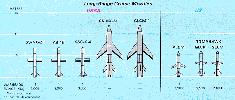 Current Systems and Force Levels. The AS-15, a small, air-launched, subsonic, low-altitude cruise missile, similar in design to the US TOMAHAWK, reached initial operational capability with the BEAR H in 1984. The AS-15 has a range of about 3,000 kilometers. The system could also be deployed on BLACKJACK bombers when that aircraft becomes operational. The combination of the AS-15 and the new BEAR H and BLACKJACK bombers will increase Soviet strategic intercontinental air power in the late 1980s. There are some 25 BEAR H bombers operational at this time.
Current Systems and Force Levels. The AS-15, a small, air-launched, subsonic, low-altitude cruise missile, similar in design to the US TOMAHAWK, reached initial operational capability with the BEAR H in 1984. The AS-15 has a range of about 3,000 kilometers. The system could also be deployed on BLACKJACK bombers when that aircraft becomes operational. The combination of the AS-15 and the new BEAR H and BLACKJACK bombers will increase Soviet strategic intercontinental air power in the late 1980s. There are some 25 BEAR H bombers operational at this time.
Force Developments. The Soviets are developing four other long-range cruise missile systems. Two of these are variants of the AS-15, and the other two are variants of a larger system probably designed for long-range operations. The latter have no US counterpart.
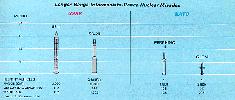 The two smaller cruise missiles are being developed for launch from sea- and ground-based platforms, respectively. The sea-based variant, the SS-NX-21, is small enough to be fired from standard Soviet torpedo tubes. Candidate launch platforms for the SS-NX-21 include: the existing VICTOR III nuclear-powered attack submarine (SSN), a new YANKEE-Class SSN and, the new AKULA, MIKE, and SIERRA Class SSNs. The SS-NX-21 is expected to become operational this year and could be deployed on submarines near US coasts.
The two smaller cruise missiles are being developed for launch from sea- and ground-based platforms, respectively. The sea-based variant, the SS-NX-21, is small enough to be fired from standard Soviet torpedo tubes. Candidate launch platforms for the SS-NX-21 include: the existing VICTOR III nuclear-powered attack submarine (SSN), a new YANKEE-Class SSN and, the new AKULA, MIKE, and SIERRA Class SSNs. The SS-NX-21 is expected to become operational this year and could be deployed on submarines near US coasts.
The ground-based SSC-X-4 variant of the small cruise missile may not be ready for operational deployment until late this year or next. Its range and the likelihood the Soviets will not deploy the system outside the USSR indicate that its mission will be in support of theater operations. The system will be mobile and probably follow operational procedures like those of the SS-20 LRINF missile.
The larger cruise missile is being developed as a sea-based system that has been designated the SS-NX-24. A newly converted YANKEE Class nuclear-powered cruise missile attack submarine (SSGN) will be the test platform for the SS-NX-24. A ground-based variant of this missile may be in development. The SS-NX-24 could be operational within the next two years, and the ground-based version sometime after that.
When first deployed, these cruise missiles probably will be fitted with nuclear warheads and capable of attacking hardened targets. Depending on future munitions developments and the types of guidance systems incorporated in their designs, they could eventually be accurate enough to permit the use of conventional warheads. With such warheads, highly accurate cruise missiles would pose a significant non-nuclear threat to US and NATO airfields and nuclear weapons in a non-nuclear conflict.
In measuring and evaluating the continuing progress being made by the USSR's strategic forces, it is useful to bear in mind the status of US forces. By mid-1985, US strategic deterrent forces will consist of:
- 1,000 MINUTEMAN ICBMs;
- 26 TITAN ICBMs;
-240 B-52G/H model bombers, plus about 23 aircraft undergoing maintenance and modification;
- 56 FB-111 bombers, plus some 5 aircraft undergoing maintenance and modification;
- 496 POSEIDON (C-3 and C-4) fleet ballistic missile launchers; and
- 144 TRIDENT fleet ballistic missile launchers.
The historic and continuing objective of US strategic forces is deterrence of nuclear and major conventional aggression against the United States and its allies. This policy has preserved nuclear peace for nearly 40 years and, in sharp contrast to the Soviet priority accorded nuclear warfighting, is based on the conviction of all postwar American administrations that there could be no winners in a nuclear conflict. Rather, US deterrence policy seeks to maintain the situation in which any potential aggressor sees little to gain and much to lose by initiating hostilities against the United States or its allies. In turn, the maintenance of peace through nuclear deterrence provides the vital opportunity to realize a complementary and constant US goal of eliminating nuclear weapons from the arsenals of all states. To realize these deterrence objectives requires the development, deployment, and maintenance of strategic forces whose size and characteristics clearly indicate to an opponent that he cannot achieve his politico-military objectives either through employment of nuclear weapons or through political coercion based on nuclear advantages. Modernization of US strategic deterrent forces is reported in Chapter VIII.
 With the initial deployment of the SS-20 LRINF missile in 1977, the Soviets launched a concerted effort to modernize and expand their intermediate-range nuclear force. Each SS-20 carries three MIRVs, thereby providing a significant force expansion factor even as the older single-RV SS-4 is withdrawn. The SS-20 also has significant improvements in accuracy and reaction time over the older missiles they are replacing.
With the initial deployment of the SS-20 LRINF missile in 1977, the Soviets launched a concerted effort to modernize and expand their intermediate-range nuclear force. Each SS-20 carries three MIRVs, thereby providing a significant force expansion factor even as the older single-RV SS-4 is withdrawn. The SS-20 also has significant improvements in accuracy and reaction time over the older missiles they are replacing.
About 400 SS-20s have been deployed, two thirds of which are opposite European NATO. Some shifting of the SS-20 force has recently been observed as the Soviets prepare for deployment of the SS-X-25 ICBM; however, no reduction in the SS-20 force is expected from this activity. The mobility of the SS-20 system enables both on- and off-road operation. As a result, the survivability of the SS-20 is greatly enhanced because detecting and targeting them is difficult when they are field deployed. Further, the SS-20 launcher has the capability of being reloaded and refired, and the Soviets stockpile refire missiles.
In addition to the SS-20 force, the Soviets still maintain some 120 SS-4 LRINF missiles. All of these missiles are located in the western USSR opposite European NATO. In addition to the land-based LRINF missile forces, the Soviets still maintain and operate 13 GOLF II-Class ballistic missile submarines. Each submarine is equipped with three SS-N-5 SLBMs. Six GOLF II units are based in the Baltic, where they continue to pose a threat to most of Europe, while the remaining seven GOLF IIs patrol the Sea of Japan, where they could be employed against targets in the Far East.
Future Force Developments. A modified version of the SS-20 is in flight test. This missile is expected to have even greater accuracy and other improvements over the current SS-20.
The initial deployment of PERSHING IIs and ground-launched cruise missiles (GLCMs) began in Europe in late 1983. Deployment will continue until 1988, when 108 PERSHING IIs and 464 GLCMs will be in place, unless a US-Soviet agreement that eliminates or limits the number of LRINF missiles on both sides is concluded. The deployment of US PERSHING II and ground-launched cruise missiles responds to the Soviet LRINF missile threat to Europe.
As the US PERSHING IIs replace the shorter range PERSHING Is and Soviet SS-23s replace the SCUDs in Europe, the Soviet Union will at least maintain its substantial numerical superiority in shorter range non-strategic nuclear missiles while improving the qualitative characteristics of its forces. The USSR also possesses a significant numerical advantage in intermediate-range nuclear force (INF) aircraft and is reducing the qualitative advantage NATO has enjoyed, despite NATO's INF aircraft modernization program, which consists of the replacement of older aircraft with the F-16 and TORNADO.
Short-range nuclear forces (SNF) consist of tube artillery and missiles of much shorter range than INF missiles. The balance in SNF artillery, traditionally an area of NATO advantage, also has shifted dramatically in favor of the Soviets in recent years. The Soviets have achieved parity in overall numbers of SNF and continue to have a substantial advantage in the category of short-range missiles, giving them more flexibility in the employment of SNF.
Current Systems and Force Levels. Armies and fronts have missile brigades equipped with 12-18 SS-1C SCUD SRBMs. Over 400 SCUD launchers are opposite European NATO; over 100 are opposite the Sino-Soviet border and in the Far East; about 75 are opposite southwest Asia and eastern Turkey; and one brigade is in strategic reserve. The SCUD is expected to be replaced by the SS-23, which has a longer range and improved accuracy. Initial deployment is anticipated opposite NATO and China. Each front commander may also have a brigade of 12-18 SCALEBOARD missiles available. They are more accurate than the SS-12 they replaced. Over 60 launchers are opposite European NATO and 40 are opposite the Sino-Soviet border in the Far East. There is one battalion opposite southwest Asia/eastern Turkey, and one brigade is in the Strategic Reserve military districts. The new generation of shorter range missiles can be employed effectively with conventional and improved conventional munitions warheads in light of their greatly increased accuracy.
In 1984, the Soviets, for the first time, forward deployed the SCALEBOARD short-range ballistic missile to Eastern Europe. These front-level missiles, which normally deploy with Soviet combined arms formations, are now in position to strike deep into NATO without having first to forward deploy.
Force Developments. It is likely that the Soviets will continue to seek improvements in their SRBM force. Improvements in guidance and control, warhead capabilities, and accuracies are expected. Such improvements will give the combined arms commanders enhanced nonnuclear targeting options and more flexible, reliable, and survivable SRBMs. These systems will be capable of delivering nuclear, chemical, or conventional warheads closer to the forward edge of the battle area and at greater depths within the military theater of operations.
Current Systems and Force Levels. At division level, the predominant weapon is the unguided FROG, found in a battalion of four launchers. The Soviets have begun to replace the FROG with the more accurate, longer range SS-21 in most divisions opposite NATO. Currently there are some 375 FROG and SS-21 launchers opposite NATO. Two hundred FROG launchers are opposite the Sino-Soviet border and in the Far East; about 100 are opposite southwest Asia and eastern Turkey; and about 75 are in the Strategic Reserve MDs.
In addition to FROG and SS-21 launchers, a division commander has some 800 nuclear capable artillery tubes at his disposal. Two new self-propelled artillery pieces, a 152-mm gun and a howitzer/mortar, are now entering the inventory. Both of these guns are nuclear capable and will bring the total number of nuclear-capable artillery tubes to over 2,000 when fully deployed. An additional 4,000 152mm howitzers have at least a potential nuclear capability.
Force Developments. As in all other nuclear attack forces, it is likely that the Soviets will improve the capabilities of their tactical missiles and nuclear artillery pieces. This improvement will be accomplished through incremental modernization of current systems and the introduction of entirely new systems.
 Immediately following World War II, Stalin committed Soviet scientists and engineers to develop the type of artillery promised by the V-1 and V-2 rockets as rapidly as possible. These weapons were to have increased ranges for use in strategic warfare and, if possible, an intercontinental capability. Stalin had assigned most missile development programs in the Soviet Union to the artillery component of the ground forces and kept their development under strict security. The prevailing Soviet view at the time was that rockets were ordnance, not pilotless aircraft. From the mission point of view, however, use of long-range missiles was assigned to Long-Range Aviation (LRA) since it was responsible for the conduct of strategic warfare. This mission assignment lasted until late 1953, when the collective leadership in the post-Stalin era stripped LRA of its operational control of ballistic missiles.
Immediately following World War II, Stalin committed Soviet scientists and engineers to develop the type of artillery promised by the V-1 and V-2 rockets as rapidly as possible. These weapons were to have increased ranges for use in strategic warfare and, if possible, an intercontinental capability. Stalin had assigned most missile development programs in the Soviet Union to the artillery component of the ground forces and kept their development under strict security. The prevailing Soviet view at the time was that rockets were ordnance, not pilotless aircraft. From the mission point of view, however, use of long-range missiles was assigned to Long-Range Aviation (LRA) since it was responsible for the conduct of strategic warfare. This mission assignment lasted until late 1953, when the collective leadership in the post-Stalin era stripped LRA of its operational control of ballistic missiles.
 In the 1950s as issues of doctrine and strategy became clearer, yet to be resolved was what service or services controlled ballistic missiles and would be responsible for their operational use. According to the Soviets, the issue was discussed at the highest levels in the Ministry of Defense and the Politburo. In late 1959, the Soviets decided to create a new service, the strategic Rocket Forces (SRF), responsible for the development, administration, training, and operation of ballistic missiles. The creation of the SRF and the appointment of M.I. Nedelinas its commander was announced in January 1960 during a session of the Supreme Soviet.
In the 1950s as issues of doctrine and strategy became clearer, yet to be resolved was what service or services controlled ballistic missiles and would be responsible for their operational use. According to the Soviets, the issue was discussed at the highest levels in the Ministry of Defense and the Politburo. In late 1959, the Soviets decided to create a new service, the strategic Rocket Forces (SRF), responsible for the development, administration, training, and operation of ballistic missiles. The creation of the SRF and the appointment of M.I. Nedelinas its commander was announced in January 1960 during a session of the Supreme Soviet.
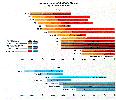 The Soviets were quick to realize that the improvements in ballistic missiles and the formation of the SRF required better technically trained personnel and combat readiness. In
addition to the training of personnel in missile maintenance and operations, the Soviets trained missile crews to meet the demands of modern nuclear warfare. As more technically sophisticated computers and automated control systems were introduced and missile systems attained higher degrees of readiness, crew sizes were reduced. The demands placed upon crew readiness, however, increased to the point where most or all ICBM and LRINF missiles could be launched in minutes. The Soviets insist that SRF personnel be combat ready at all times. As a result, Soviet missile crews are regularly trained for the contingencies of preemption, launch-on-tactical-warning, or a second strike attack. An additional part of crew training is reconstitution and refire of those silos
not destroyed in a counterattack. In keeping with the demands of Soviet nuclear doctrine,missile crews are trained to perform their tasks under any contingency.
The Soviets were quick to realize that the improvements in ballistic missiles and the formation of the SRF required better technically trained personnel and combat readiness. In
addition to the training of personnel in missile maintenance and operations, the Soviets trained missile crews to meet the demands of modern nuclear warfare. As more technically sophisticated computers and automated control systems were introduced and missile systems attained higher degrees of readiness, crew sizes were reduced. The demands placed upon crew readiness, however, increased to the point where most or all ICBM and LRINF missiles could be launched in minutes. The Soviets insist that SRF personnel be combat ready at all times. As a result, Soviet missile crews are regularly trained for the contingencies of preemption, launch-on-tactical-warning, or a second strike attack. An additional part of crew training is reconstitution and refire of those silos
not destroyed in a counterattack. In keeping with the demands of Soviet nuclear doctrine,missile crews are trained to perform their tasks under any contingency.